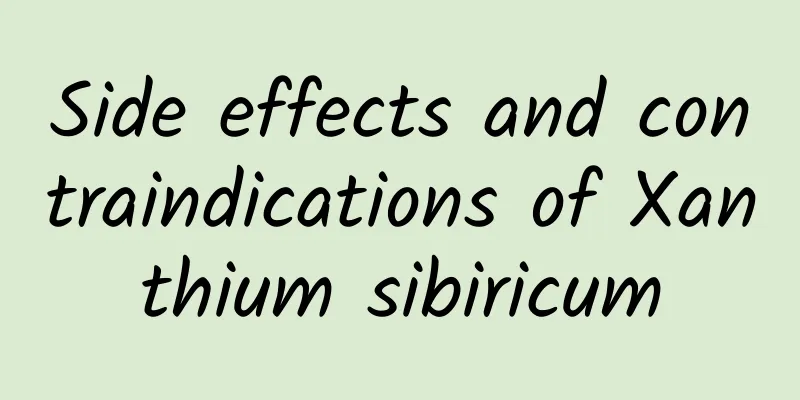Side effects and contraindications of Xanthium sibiricum

|
At present, there are no significant side effects during the use process. If it is for some special patients, such as pregnant women, the elderly, children, or breastfeeding women, they must go to the hospital to consult a doctor and take the medicine under the doctor's guidance. In addition, when taking the medicine, it must be taken after meals, and patients with gastrointestinal yin deficiency and internal heat should take the medicine with caution. It can dispel wind, clear lung heat, clear nasal passages, and relieve headaches. It can be used for dysentery caused by wind-cold and wind-heat. For example, it can be used to treat acute and chronic rhinitis or sinusitis, as well as seasonal allergic rhinitis. Xanthium sibiricum is a common Chinese medicinal material. It tastes slightly bitter and sweet, is warm in nature, is toxic, and belongs to the lung meridian. It is also called old Xanthium sibiricum, Taoist Head Number, and Cibaluo. Xanthium sibiricum is mainly used to treat rheumatism, cold arthralgia, carbuncle, limb cramps and pain, epilepsy and other symptoms. Because Xanthium sibiricum has certain toxic side effects, taking too much may cause side effects. Some patients may experience symptoms of mild poisoning, such as dizziness, headache, nausea, vomiting, abdominal pain, etc. In more serious cases, other psychiatric symptoms may also appear, such as anxiety, impaired consciousness, etc. Xanthium sibiricum is the dried, perfect, involucral fruit of the Xanthium sibiricum plant of the Asteraceae family. It tastes slightly bitter, is warm in nature and is toxic. Its function is to dispel cold and dampness, and it is mainly used to treat headaches, body aches, and limb cramps caused by rheumatism. It is often combined with Notopterygium wilfordii, Clematis chinensis, and Glechoma longituba. The second is to clear the nasal passages, which can treat various rhinitis and excessive runny nose, such as sinusitis, allergic rhinitis, etc., and are often combined with gardenia, white peony, asarum and other medicines. The third is to eliminate parasites, eliminate knots and relieve itching, and treat various types of ringworm, scabies, rubella, prurigo, etc. which are mainly caused by itching. Xanthium sibiricum is toxic and should not be used in excess. Xanthium sibiricum should not be used for headaches and body pains caused by deficiency of both Qi and blood. |
<<: Coriander root benefits and uses
>>: Banxia Houpu Decoction Composition
Recommend
The efficacy and function of Herba Dioscoreae
Everyone is familiar with the Herba Cynoglossi, w...
CNNIC: Data shows that nearly 80% of users recognize the security of online payment
Nearly 80% of users recognize the security of onl...
Cell death, is it "suicide" or "accident"?
Audit expert: Ji Shi Life Field Observer Humans a...
Lunar exploration "power decoding"! Which engines were used in the Chang'e 6 exploration mission?
On July 12, 2024, Wu Baoyuan, a researcher at the...
Alibaba: Alimama Business Guide Vol.03
Based on the insights into the crowd in the previ...
How much do you know about the jokes in the Spring Festival Gala? Come and understand the stories that have been forgotten for thousands of years
The tadpole wishes you a happy new year! Did ever...
The teacher is so cool! Looking back at the famous scenes of teaching in space
September 10, 2023 is the 39th Teachers' Day ...
Why is the panda Qizai brown and white? Scientists have written a family tree for it丨Bolan Daily
Your best "insider" in the scientific c...
National Nuclear Emergency Publicity Week丨Nuclear? Nuclear medicine? Learn everything in one article!
In the hospital, when many patients receive the e...
[Smart Farmers] A "iron watermelon" grows on a gourd tree! How powerful is this "all-rounder" in the plant world?
Your browser does not support the video tag Calab...
The efficacy and function of tendon vine
Nowadays, our living standards are constantly imp...
Is it easy to eat and drink healthily during the Spring Festival? Just remember these few numbers →
During the Spring Festival, there are so many del...
What are the effects of fresh black wolfberry wine?
Wolfberry is a very common Chinese medicine. It v...
What are the dangers of eating too much Lingzhi?
Ganoderma lucidum has been regarded as the holy h...
Can Acanthopanax Seeds Treat High Blood Pressure?
When it comes to Acanthopanax senticosus, everyon...









